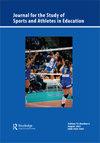校际篮球的竞争平衡:对政策与非政策因素的考察
IF 1
Q3 EDUCATION & EDUCATIONAL RESEARCH
Journal for the Study of Sports and Athletes in Education
Pub Date : 2019-09-02
DOI:10.1080/19357397.2019.1674592
引用次数: 3
摘要
在校际男子篮球比赛中,不成比例的州比赛成功一直是竞争平衡政策的催化剂。各州体育协会根据各种特征采取政策,这些特征通常包括公共/私人状态。本研究以分配正义理论为框架,探讨男篮的竞争平衡格局,并探讨哪些学校特征对不成比例成功的影响最大。结果表明,在最小招生分类中的私立学校有最高的不成比例的成功,城市私立学校有最高水平的持续成功,超出招生分类的政策在很大程度上是无效的,并且由于各州之间的细微差别,预测广泛的成功是不可能的。实际应用表明,国家或地区竞争平衡政策并不实用,但城市私立学校在招生规模较小的分类中取得成功应成为各州政策制定的一个考虑因素。本文章由计算机程序翻译,如有差异,请以英文原文为准。
Competitive balance in interscholastic basketball: An examination of policy and non-policy factors
ABSTRACT Disproportional state tournament success within interscholastic boys basketball has been the catalyst for competitive balance policies. State athletic associations adopt policies based on a variety of characteristics that often include public/private status. Using the theory of distributive justice as a framework, the purpose of this study was to determine the competitive balance landscape of boys basketball, as well as investigate which school characteristics most impact disproportionate success. Results indicated that private schools in the smallest enrollment classifications had the highest disproportionate success, urban private schools had the highest levels of sustained success, policies beyond enrollment classifications are largely ineffective, and predicting widespread success was not possible due to the nuances among states. The practical application indicates that national or regional competitive balance polices are not pragmatic, but urban private school success in smaller enrollment classifications should be one consideration for individual state policy development.
求助全文
通过发布文献求助,成功后即可免费获取论文全文。
去求助
来源期刊

Journal for the Study of Sports and Athletes in Education
EDUCATION & EDUCATIONAL RESEARCH-
自引率
0.00%
发文量
25
 求助内容:
求助内容: 应助结果提醒方式:
应助结果提醒方式:


